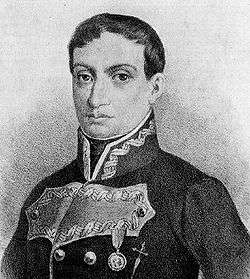Third Siege of Girona
| Siege of Girona | |||||||
|---|---|---|---|---|---|---|---|
| Part of the Peninsular War | |||||||
 The Great Day of Girona by Ramón Martí Alsina. | |||||||
| |||||||
| Belligerents | |||||||
|
|
| ||||||
| Commanders and leaders | |||||||
|
Laurent de Gouvion St-Cyr Pierre Augereau | Mariano Alvarez de Castro (POW) | ||||||
| Strength | |||||||
|
35,000 regulars 40 guns | 5,600 regulars and militia | ||||||
| Casualties and losses | |||||||
| 14,000 dead, wounded, or ill[1] |
5,000 dead 1,200 wounded 3,000 captured[1] | ||||||
The Third Siege of Girona refers to the French Grande Armée's seven-month siege of Girona, from 6 May to 12 December 1809, a significant event in the Peninsular War.
Some 18,000 French and Westphalian troops, commanded by General Laurent de Gouvion Saint-Cyr during much of the siege, before Marshal Pierre Augereau took command on 12 October besieged the town, which held out under General Mariano Alvarez de Castro, in command of some 5,600 regular troops and militiamen, until disease and famine compelled it to capitulate on 12 December.
Background

With Joseph Bonaparte having acceded to the throne of Spain in 1808, the following year, General Alvarez, commander of Montjuïc Castle in Barcelona, was ordered by his superiors to hand it over, despiting having been prepared to resist. Alvarez left Barcelona and joined the Spanish rebels against French rule. The Spanish Government in Cadiz named him commander of the Army of Catalonia and Governor of Girona, a city with a garrison of between 3,400[2]–5,600 regular troops belonging to the Ultonia Regiment.
Taking command of the strategic city on 1 February 1809, he immediately started preparing its defence, requesting provisions for 7,000 men. On 1 April, he proclaimed his famous edict, to the effect that if the city were attacked, he would immediately execute anybody that mentioned surrender or capitulation. On 3 May, arms were distributed to 1717 volunteers.[3]
Siege
At the beginning of May 1809, Saint-Cyr starting setting up the batteries and fortifications, mounting 40 gun batteries that over the next seven months fired some 20,000 explosive shells and 60,000 cannonballs into the city. On 12 June, Alvarez rejected the terms of truce offered, and General Saint-Cyr ordered bombardment to commence after midnight 13–14 June.
Towards the end of September, General Saint-Cyr left his command, angered by the fact he was to be replaced as the head of the French and Allied force. He left the troops without an overall commander for several days, in clear disobedience of orders received in June.
Although the castle at Girona, confusingly also named Montjuïc, had been taken by the French in August, Alvarez barricaded and entrenched the city, and battle continued for another four months before Alvarez, seriously ill, handed over command to Brigadier Juan Bolivar. Two days later, on 12 December, the town capitulated. It is estimated that some 10,000 people (soldiers and civilians) died inside. French losses were approximately 15,000, over half of those to disease.
Owing to the long delays and heavy losses suffered by the French, the town's resistance served Spanish purposes. The battle became something of a legend over the course of Spain's war of independence, and Alvarez himself, a national hero. In spite of Alvarez's poor health, the French first imprisoned him, and the other officers from Girona, at Perpignan before taking him to stand trial for treason at the castle of San Fernando, where he died the following month.[4]
References
- 1 2 3 Gates, David. The Spanish Ulcer: A History of the Peninsular War, p. 172. Da Capo Press 2001. ISBN 0-306-81083-2
- ↑ The Edinburgh Annual Register for 1809, p. 769. At Google Books. Retrieved 3 August 2013.
- ↑ (in Spanish) Grahit y Papell, Emilio (1896) Historia de los sitios de Gerona en 1808 y 1809, pp. 69–71. Ministerio de Educación, Cultura y Deporte. Retrieved 3 August 2013.
- ↑ "Álvarez de Castro y su tiempo" (PDF). congreso.es (in Spanish). 2010. Retrieved 3 August 2013.
External links
Coordinates: 41°59′04″N 2°49′16″E / 41.9844°N 2.8211°E